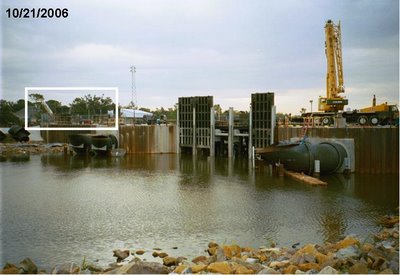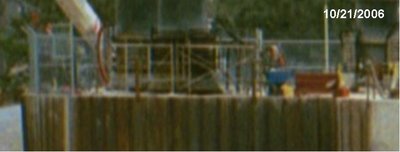Back to the floodgates - a Fixthepumps Follow-up
After my five (and then six) part series, "Problems at the floodgates," I figured there'd be some action on the items I uncovered. The record has been mixed so far. Some areas remain totally unaddressed, while others have had a little response. Overall, I'd say we're still at the same point we were when the special report was published.
Part 1 of the report was about the distinct lack of security at the three floodgate sites. I'm pleased to report that there has been some improvement at the Orleans and London Avenue sites, but 17th Street remains scarily wide open for anyone to move around and do mischief.
At Orleans and London Avenues, eight foot high chain link fences have been erected around each control/engine structure, except for the east control building at London Avenue. At that structure, half of the chain link fabric has not been attached to the poles, leaving that structure vulnerable to mischief at night (there's still no on duty security). The fences are topped with three strands of barbed wire. All the gates on these fences are kept locked. Here's a picture of the fence around the west side control building at Orleans Avenue:

If you click on the picture and blow it up a bit, you'll see the fence around the perimeter of the structure.
The contractors at this site also must access the gates structures themselves through another chain link fence-and-gate on each bank of the canal. Before my special report, these gates were routinely left wide open in the evening after the contractors left for the day. Now they are always locked. You can see the gates on this picture of the Orleans Avenue gates.

Here's an enlargement to make it clearer:

So Orleans Avenue is pretty secure now, and London Avenue is getting there. However, the 17th St. site is still swiss cheese when it comes to security. And it's not like Boh Brothers and the Corps don't know where the fences are supposed to be. The 17th Street floodgates construction specifications say the following about fencing:
i. Security Fence. The Contractor shall provide, erect, and maintain a temporary security fence around the accessible limits of the land side construction easement shown on the rights of way drawing [my emphasis]. Fencing shall consist of a 8 foot high chain link fence with three strands of barbed wire supported on angled arms at the top. To provide access, the fence shall have a minimum 16 foot wide gate with keyed lock. The Contractor shall provide and maintain on the fence "KEEP OUT" signs every 100 feet facing out from the staging area. Details of the security fence and location shall be submitted to the Contracting Officer for approval. No separate measurement will be made for this work. Payment for all work associated with the security fence shall be included in the contract lump sum price for “CHAIN LINK FENCE”.
Here's the construction easement drawing:

Here's the area that has no fence. I've highlighted the exact length that is missing in red.

And here's a picture of the same area from last weekend. I roughed in where the fence is supposed to be:

It's been this way since the beginning of the job. Boh Brothers and the Corps are ignoring their own specifications at the peril of whatever yahoo wants to wander on the site. Heaven help us if someone hurts themselves because they could just wander up on the gate structures and plunk themselves into the canal, which is 18 feet deep.
[Update, 7/9/07:
The Corps eventually got its contractor to put up the fence where it belonged. It went up in November or December, 2006. This shot of the east drive platform from June of 2007 shows the fence in the foreground:

end update]
But it's not just security that is still lax at the gates. In part 2 of the special report, I wrote about workplace safety, and how the 17th Street canal site is a huge mess of violations of OSHA and Corps of Engineers safety standards. At the time of my report, I couldn't report on the behavior of workers because Deep Flood's pictures were taken after the workers had left for the day (more about that later...).
When I went out there over the weekend, it was in the morning after the contractors had reported for work. At that time, I observed an unsafe behavior that would easily get someone fired on the spot at any private industrial facility in the country. It is a very strong indication that there is very little - if any - emphasis on working safely on the 17th Street site.
Here's the first photo. I've highlighted the area of interest. Note how high the people in the box are above the ground. It's about 20 feet.

Here's that area blown up, with notes about what's going on. The man on the right appears to be a supervisor of some sort.

For reference, here's a Deep Flood photo of the area on which these men are walking:

Here's another picture taken shortly afterward. You can see how high off the ground the highlighted worker is:

And again, here's a blowup of the highighted area showing the worker:

As I mentioned in my original report, the contractor on the job is obliged to follow all the safety regulations found in 29 CFR 1910 (OSHA's regular workplace safety regulations) and 29 CFR 1926 (OSHA's construction site safety regulations). Here's the particular regulation whose violation is captured in the above photos:
29 CFR 1926.501(b)(1)
"Unprotected sides and edges. Each employee on a walking/working surface (horizontal and vertical surface) with an unprotected side or edge which is 6 feet (1.8 m) or more above a lower level shall be protected from falling by the use of guardrail systems, safety net systems, or personal fall arrest systems."
This is found in the section of the regulations titled "Duty To Have Fall Protection." At some private industrial facilities, the standard is actually 4 feet.
The Corps has their own safety manual, EM 385-1-1. It has this to say about the requirements for fall protection in chapter 21:
And this is not a one-time occurrence. Here's some welders working on modifying the discharge pipes on the east side of the canal at 17th Street on October 11th. All three of these workers are over the water:a. Employees exposed to fall hazards shall be protected by standard guardrail, catch platforms, temporary floors, safety nets, personal fall protection devices, or the equivalent, in the following situations:
(1) On accessways (excluding ladders), work platforms, or walking/working surfaces from which they may fall 6 ft (1.8m) or more;
(2) On accessways or work platforms over water, machinery, or dangerous operations;
(3) On runways from which they may fall 4 ft (1.2 m) or more; and
(4) On installing or removing sheet pile, h-piles, cofferdams, or other interlocking materials from which they may fall 6 ft (1.8 m) or more.

And, as before, the highlighted area:

The lack of fall protection seems to more of a endemic pattern than a rare exception. I pity the workers whose managers and Corps overseers care so little about their safety that they refuse to enforce the rules.
There is something you can do about this. Another provision of the contract specifications relating to contractor safety talks about what happens in the event of a violation:
The provisions don't say how the Contracting Officer is to be made aware, so I suppose reading it on a website is as good a method as any. I would suggest you help me make the Corps aware of these OSHA violations. You can email the upper reaches of the Corps New Orleans District with an email such as the following:"Whenever the Contracting Officer becomes aware of any noncompliance with these requirements or any condition which poses a serious or imminent danger to the health or safety of the public or Government personnel, the Contracting Officer shall notify the Contractor orally, with written confirmation, and request immediate initiation of corrective action. This notice, when delivered to the Contractor or the Contractor's representative at the work site, shall be deemed sufficient notice of the noncompliance and that corrective action is required. After receiving the notice, the Contractor shall immediately take corrective action. If the Contractor fails or refuses to promptly take corrective action, the Contracting Officer may issue an order stopping all or part of the work until satisfactory corrective action has been taken. The Contractor shall not be entitled to any equitable adjustment of the contract price or extension of the performance schedule on any stop work order issued under this clause."
Dear Corps personnel:
Please be aware that photos of violations of OSHA and Corps of Engineers regulations relating to the use of fall protection by contracted employees the 17th Street Canal Interim Closure Structure have recently been posted at the following website: http://www.fixthepumps.blogspot.com/. Please pass this information along to the responsible Contracting Officer, so that he or she may notify the Contractor and corrective action may be taken.
Sincerely,
[Your name]
Here's a list of email addresses to put in the "To:" field
Richard.P.Wagenaar@mvn02.usace.army.mil, Murray.P.Starkel.LTC@mvn02.usace.army.mil, Jeffrey.A.Bedey@nwo02.usace.army.mil, James.J.StGermain@mvn02.usace.army.mil, christophor.e.gilmore@mvn02.usace.army.mil, Gregory.E.Breerwood@mvn02.usace.army.mil, walter.o.baumy@mvn02.usace.army.mil, Michael.L.Lowe@mvn02.usace.army.mil, robert.crear@mvd02.usace.army.mil, albert.m.bleakley@mvd02.usace.army.mil, david.w.sills@mvd02.usace.army.mil, Dianne.Allen@MVN02.usace.army.mil
I already sent one. I'll let you know if I receive a response.

0 Comments:
Post a Comment
<< Home